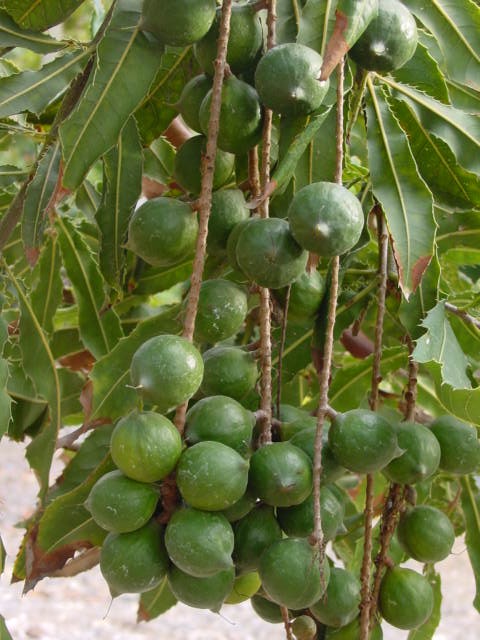| |
Macadamia Nut (Macadamia Integrifolia)
 |
Macadamia nut oil is often referred to as being nearly perfect, and there are many reasons for that.
The nut’s oil is nutritious — a great source of calcium, B complex, phosphorus and iron. It contains 73-80% mono-saturated fat. Macadamia nut oil contains the highest amount of palmitoleic acid (an Omega 7 fatty acid) of any plant. Palmitoleic acid is plentiful in our skin when we are young, but decreases with aging. This acid is believed to help mature skin retain suppleness. Palmitoleic acid also replaces naturally occurring skin on the lips, allowing the skin to remain younger looking.
Macadamia oil reduces wrinkles and dryness. It is a natural moisturizer and emollient (emollients attract and trap moisture from the air). Macadamia oil is light and non-greasy so it is easily absorbed into the hair shaft and skin. Another gift of macadamia nut oil is that it contains proteins, and its vitamin E contributes skin-care benefits and long shelf life. The high count of mono-unsaturated fatty acids makes the oil mimic the sebum (naturally produced oil on scalp and skin which protects it from damage). All of these qualities contribute to its reputation as a superb hair and skin treat, as well as an elixir for healing scars, sunburn, wounds and irritations.
Speaking of skin perfection, macadamia oil is considered one of the best carrier oils available; carrier oils are used along with dilute amounts of essential oils in aromatherapeutic treatments and massage.
As edible treats, the nuts — crunchy, delectable, sweet — are also loaded with benefits. Still considered somewhat rare in most areas, macadamia nuts have a complex and dense flavor that makes us want more. Macadamia nuts originated and still flourish in the rainforests of Southeastern and Northeastern coastal Australia. Although we associate macadamia nuts with Hawaii, the largest orchards are actually in South Africa.
>Distribution
Macadamia trees may have originated in Australia, but today they grow in nearby New Zealand, in the African countries of South Africa, Malawi and Kenya, in South and Central America, Mexico and Israel. In North America, they can be found in Hawaii, California and Florida.
There are generally two types of macadamia nuts : Macadamia integrefolia Maiden & Betche, smooth-shelled nuts, and Macadamia tetraphylla L. Johnson, the rough-shelled nuts. A hybrid of the two also exists.
The tree belongs to the Protaceae family. Of Protaceae’s 10 species, macadamias are the most commercially viable. The trees constantly produce nuts, but they grow at a very slow rate. Demand has exceeded available product making them truly a fragile commodity that should be used with care.
Growth, Habit and Culture
Macadamia trees are majestic, ranging from 30 to 40 feet high. They prefer full, sun, non-windy locations, although partial shade is tolerated in hot climates, They grow in a wide range of soils, from sandy or rocky lava soils to heavy clay soils. The trees prefer rich soil with balanced a pH. Macadamias will not tolerate soil or water with high salt concentrations. In areas with low annual rainfall, macadamias leach the soil regularly. They can survive drought conditions, although it has a negative effect on nut production.
The bark is rough-textured, yet has a consistent, surface (no groves or ridges) and dark reddish brown color. Macadamia trees have thick clusters of rootlets in deliberate rows around the parent root. The roots provide the tree with maximum absorption. Seedlings grow well because of the root constellation.
Macadamia nuts have a very hard seed coat enclosed in a green husk that splits open as the nut matures. The seed coat is smooth in the case of M. integrifolia, containing an off-white kernel that contains approximately 80% oil and 4% sugar. Roasting enhances the color and texture. M. tetraphylla, called rough-shelled macadamia, sometimes has a smooth seed coating or it is rough and pebbled. The oil content of M. tetraphylla ranges from 65 percent to 75 percent; sugar content is from 6 percent to 8 percent.
Harvesting
It is best to wait for the mature macadamia nuts to fall to the ground, which occurs from late fall to spring. Most people, however, harvest the fallen nuts to protect the full crop from damage. A productive tree produces between 30 and 50 pounds of nuts at about 10 years of age, increasing production for years before going into decline.
The nuts must be de-husked with great care and there are generally people who do this as a job. The macadamia nuts are allowed to dry in the sun for several weeks first. Then put into the oven at a very low temperature for about 12 hours and stirred occasionally. Then they are stored in a cool dry place until ready to use.
Suggested Health and Beauty Uses
Macadamia nut oil has even more mono-saturated fats than olive or canola oil. Mono-saturated fats are considered good fats that actually reduce high blood pressure and raw occurrence of heart disease. It also has a very high omego-3 acid count. Omega-3 reduces the risks of arthritis, heart diseases and high blood pressure. Omega-3 also keep cells healthy. The ratio of Omega-3 to Omega-6 is considered important. Macadamia nut oil has more Omega-3 fatty acids than Omega-6 acids, which makes it a healthier choice. Look for cold-pressed oils.
Disclaimer: The information presented herein is intended for educational purposes only. These statements have not been evaluated by the FDA and are not intended to diagnose, cure, treat or prevent disease. Individual results may vary, and before using any supplements, it is always advisable to consult with your own health care provider.
|
|


















